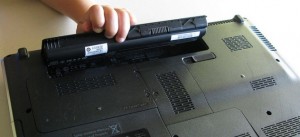6.- Disk drive (CD/DVD/Blu-Ray)
We’ll try to work our optical drive both by software and hardware (opening it both by the O.S. and with the button). If it all goes well, we’ll check that the laser hasn’t shifted and we’ll put a disc in for testing.
If it doesn’t open by software or hardware but responds to commands, it’s possible that some loose piece/ piece of plastic has blocked it. We’d have to force it with a clip or a small knife to open the unit and remove the blockage. If it doesn’t even follow commands, its feeder cable has disconnected and we have to open it to reconnect. If, however, it responds and opens but the PC doesn’t READ IT or DETECT IT, then the data transmission cable came loose and we have to reconnect it to our motherboard.
7.- Speakers
We access YouTube, for example, and load a video. If everything sounds right, we don’t have any problem. However, we also have to check if any strange noises come out with the sound.
If there is no sound or it has some strange “tinny” sound, we could consider buying some external computer speakers. Similar to previous cases, we should check how affordable this solution is in comparison to fixing it and also how comfortable we’ll be with it.
8.- Webcam y Microphones
Test and verify how undamaged your Webcam and microphones still are (record a video, use Skype, etc.), make sure that the video and sound have the same quality as always.
If the webcam and/or microphone have some serious problems or aren’t working, consider changing them for external components that, for example, can be connected via USB.
9.- Charging unit and battery
Connect the charger to the computer and verify that the battery charging effectively, we’ll also need to ensure that the battery still works autonomously without the charger. It’s important to check that there’s no physical damage to the battery, because then we’d have to change it for our safety, the computer’s and also to ensure proper operation.
Fix: If the charging unit doesn’t work, we need to open the computer and check that it’s still in place and hasn’t moved. In this case, it’d be better to call for technical support. If, on the other hand, the battery has problems (no autonomy without the charger) this has to do with displacement of the contact plates, and we’d still have to put them back or ask a technician to do so.
10.- Hard Drive
We’d have to force a thorough error check in our hard drive as soon as the system runs, no matter what O.S. we have, getting the computer to repair all of the possible errors during this task. We’d also have to do a SMART check to get an idea of the health and conditions of coherence that the disk has after the shock.
If there is any damage in the hard drive (shown by the first test) it can be treatable and the same diagnostic assistant we used could repair it. If the SMART test reveals any problems, considered CHANGING the hard drive IMMEDIATELY for another one, be internal or external. If you don’t know how to run these tests on your operating system, leave a comment below and I’ll explain it.
BIOS Diagnostics and Hardware List
Some computers have diagnostic assistants at a BIOS level when we turn then on. If yours has this, run all possible diagnostic assistants and analyze the data acquired to get an idea of whether something is damaged or not. Likewise, all O.S. have ways if listing all of the computer’s available hardware. Make the O.S. give you an available hardware list and check that all of the components have been effectively detected and are working.
When we turn the computer on, when the manufacturer’s logo shows up, we are given several options, one of which is self-diagnosis. In some cases, if you can make the computer self-check with its “firmware” (to call it in some way) do it as soon as possible. If you don’t know how to do this or how to get an available hardware list from your O.S., leave a comment below and I’ll explain how to do it.
My last recommendation, which wouldn’t fit in my 10 tips, is that if you want to and if you can, use your warranty after a shock to you change your computer for another one and thus you’ll no longer have doubts about whether everything is working or not… If your warranty doesn’t cover this (or you no longer have it) then I guess these 10 tips might’ve been great for you.
Finally, if you live in Houston, Spring, The Woodlands or other nearby areas in Texas, you can always call 911-computer.com. One of our technicians will check your laptop, provide you with a proper diagnosis along with an accurate quote of how much it’ll cost to repair your laptop, so that you can make the best decision.






